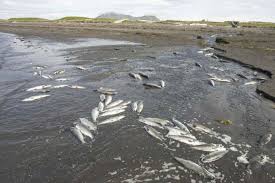BILLIONS of dead fish now washing up in Alaska from radiation-polluted Pacific Ocean
08/25/2015 / By Greg White

Something smells fishy in Alaska’s waters. Hundreds of dead fish were found dead on Front Beach in downtown Alaska last Tuesday. In addition, high temperatures and low river levels are killing salmon in Matanuska and Susitna valleys.(1, 2)
These reports coincide with a number of dead whales, birds and fish being found in the Aleutian Islands. A dead Steller’s sea lion landed on the shore in Unalaska last July. Experts are unsure what caused the sea lion’s death. The carcass of the dead sea creature did not display wounds.(1)
Warm ocean temperatures cook marine life
Water temperatures were as high as 74 degrees in Jim Creek, which is a small tributary of the Knik River. Many dead salmon were discovered in the river’s weir, whereas others were discovered in Mat-Su streams, such as Lucille Creek, Fish Creek, and Cottonwood Creek.(2)
An estimated 500 freshly stocked Arctic char died because of warm water temperatures in Little Campbell Lake, which is located in Kincaid Park in West Anchorage. The temperatures rose to 70 degrees in the lake, which is lethal to fish that are not native to Southcentral Alaska like the Arctic char.(2)
Little Campbell Lake plunges 18 feet deep, making it relatively safe for the non-native Arctic char. It has been regarded as one of the best municipal lakes for char fishing. This year, however, high temperatures depleted the lake of much oxygen, as has occurred in another lake in Anchorage years before, causing many fish to go belly-up.(2)
There are various hypotheses circulating in the air about what is causing warm temperatures in the ocean. Experts suspect that toxic algae might be the culprit, which were summoned by unusually warm ocean temperatures. This is one of the hottest summers on record to plague Southcentral Alaska, according to the National Weather Service; however, the NWS is the same agency that claims it would be unscientific to not use erroneous temperature data when calculating climate trends. A lack of snow and rainfall has also contributed to low river levels.
Mussels from two different bays in Unalaska were discovered to have levels of toxins that trigger paralytic shellfish poisoning that were two to four times higher than safety levels set by the U.S. Food and Drug Administration. This spring, for instance, some mussels were discovered to have up to 3.3 parts per million of the noxious PSP toxin, which is four time higher than the FDA’s 0.8 parts per million limit.(1)
Fukushima radiation warming ocean water
Scientists suspect that some of the fish were bait fish that were were dumped into the ocean, since their fins were deteriorating but their eyes were intact. Nevertheless, experts believe that the high level of toxins in fish are due to this summer’s algae blooms, although at least one dead whale corpse has tested negative for domoic acid produced by algae, and scientists are now awaiting results to determine if radiation from Fukushima might be involved.
A warm body of water in the Pacific Ocean known infamously as “the blob” has been cited as the culprit behind dangerous algae blooms. The blob encompasses a diameter of 1,000 miles, is 300 feet deep and stretches from California to Alaska.
The blob was discovered in 2013. No one is sure what is fueling the blob; however, radioactive waste from the Fukushima Daiichi power plant may bear some responsibility.
In 2011, a tsunami laid waste to three nuclear reactors at the Fukushima Daiichi power plant. Hundreds of tons of radioactive waste have been leaking into the ocean since the disaster. The radioactive isotopes released from the plant could be gradually cooking the ocean, which may explain the onset of the blob. The radiation from the Fukushima disaster was expected to reach the West Coast by late 2013/early 2014, which just so happens to coincide with the rise in dead marine life in California and Alaska.
The mainstream media has underplayed the severity of the disaster in order to prevent a mass panic and protect the nuclear industry (including General Electric, which owns NBC). While ignorance maintains civility and corporate revenue, it doesn’t allow people to adequately prepare for oncoming disasters. As radiation from the Fukushima disaster continues to bombard the cost, dead marine life is expected to rise.
Sources include:
(1) ADN.com
(2) AlaskaPublic.org
Submit a correction >>
Tagged Under:
Alaska, dead fish, marine life, Pacific Ocean, radiation, West Coast
This article may contain statements that reflect the opinion of the author
RECENT NEWS & ARTICLES
COPYRIGHT © 2017 FUKUSHIMAWATCH.COM
All content posted on this site is protected under Free Speech. FukushimaWatch.com is not responsible for content written by contributing authors. The information on this site is provided for educational and entertainment purposes only. It is not intended as a substitute for professional advice of any kind. FukushimaWatch.com assumes no responsibility for the use or misuse of this material. All trademarks, registered trademarks and service marks mentioned on this site are the property of their respective owners.




















